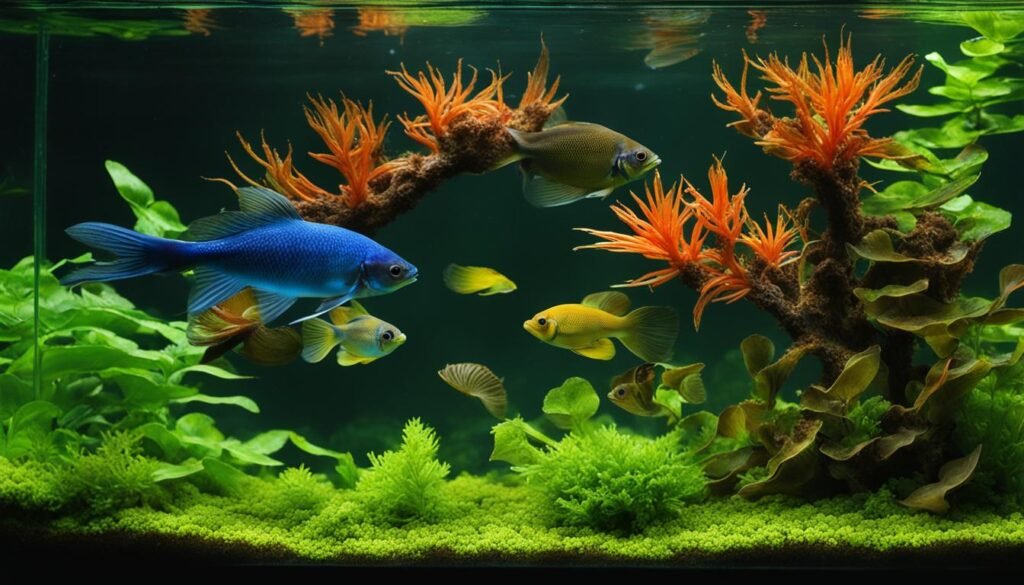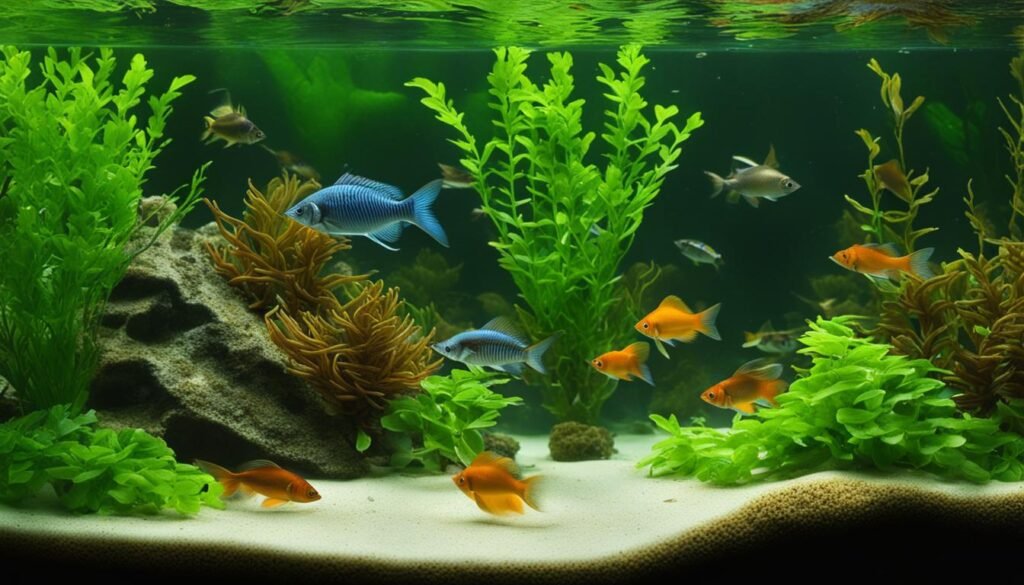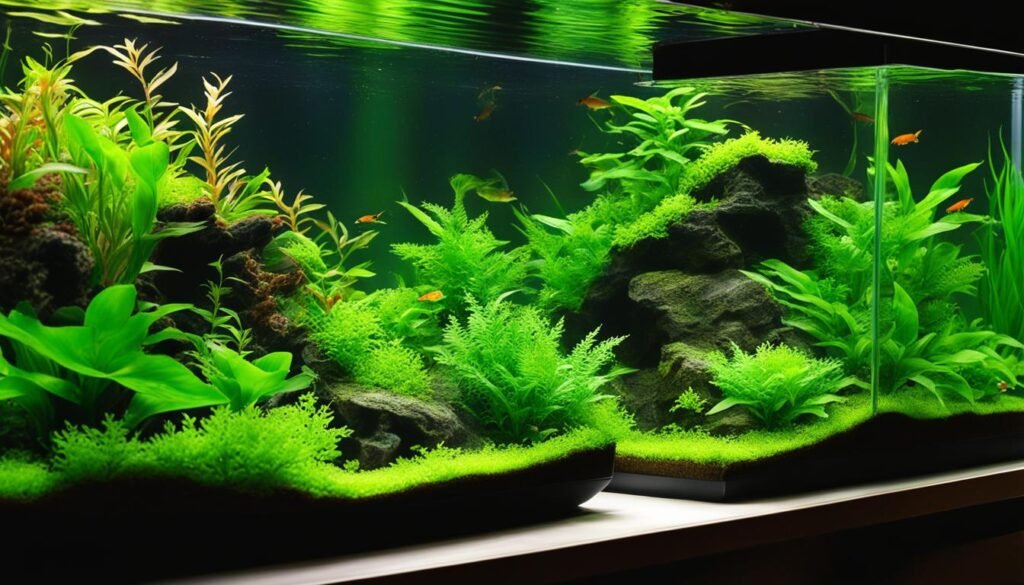Your cart is currently empty!

Can Dying Aquarium Plants Kill Fish?
Welcome to our comprehensive guide on the potential risks of dying aquarium plants and their impact on fish. While live aquarium plants can provide numerous benefits to your tank, it’s crucial to understand that they can also pose risks to the health and survival of your fish if not properly cared for. In this article, we will explore the consequences of dying aquarium plants and provide you with insights on how to create a safe and healthy environment for your aquatic pets.
Key Takeaways:
- Improper care of dying aquarium plants can have detrimental effects on fish health and survival.
- Ich, a common disease, can affect both fish and aquarium plants, requiring treatment for both.
- Rotting plants in the aquarium can lead to toxic ammonia buildup, harmful to fish.
- Choosing the right aquarium plants and preventing overgrowth is essential for maintaining a healthy tank environment.
- Plastic aquarium plants may release harmful chemicals into the water, posing risks to fish.
The Impact of Ich on Aquarium Plants and Fish
Aquarium plants are not immune to the effects of ich, a common and highly contagious disease that can infect both fish and plants in your tank. Ich, also known as white spot disease, is caused by a parasite that can contaminate the water and any objects within the aquarium. This includes the plants, which can become infected and suffer from the presence of ich.
When aquarium plants are infected with ich, it can lead to a number of negative consequences. The parasite attaches itself to the leaves and stems of the plants, causing damage and potentially inhibiting their growth. In severe cases, ich can even cause the plants to wither and die. This not only affects the aesthetic appeal of your tank but can also disrupt the overall balance and health of the aquatic environment.
It’s important to note that treating ich in aquarium plants is just as crucial as treating it in fish. If left unaddressed, the disease can continue to spread and potentially cause harm to other fish and plants in the tank. Salt treatment and raising the tank temperature are commonly used methods to eliminate ich from the tank. However, it’s essential to carefully monitor the plants throughout the treatment process to ensure their well-being and promote their recovery.
The Key Points:
- Ich can infect and damage aquarium plants, impacting their growth and even causing them to wither and die.
- Treating ich in aquarium plants is essential to prevent the spread of the disease and maintain the health of the tank.
- Salt treatment and raising the tank temperature are common methods for eliminating ich from the tank, but careful monitoring of the plants is necessary.
The Dangers of Plant Rot in Aquariums

Aquarium plants are not immune to decay and rot, and when they start to break down, they can pose serious risks to the health of your fish. When plants in your aquarium begin to rot, they release organic matter into the water. This organic matter becomes a food source for harmful bacteria, which leads to an increase in ammonia levels in the tank.
Ammonia is highly toxic to fish and can cause significant harm, including fish stress, damage to the gills, and even death. The increase in ammonia levels also leads to the production of nitrites, another toxic substance that can further compromise fish health. Therefore, it is crucial to prevent plant rot in your aquarium to maintain a safe and healthy environment for your fish.
The consequences of plant rot in an aquarium:
- Ammonia buildup in the tank
- Toxicity of nitrites to fish
- Compromised fish health due to exposure to toxic ammonia
To prevent plant rot in your aquarium, it is essential to provide proper care for your plants. This includes ensuring they have adequate lighting for photosynthesis, providing them with the necessary nutrients through a balanced fertilizer regimen, and regularly pruning and removing dead plant material from the tank.
Additionally, maintaining good water quality is crucial in preventing plant rot. Regular water testing, efficient filtration, and performing regular water changes to remove excess nutrients and waste will help ensure a stable and healthy environment for both your plants and your fish.
By taking these preventative measures and staying vigilant in monitoring the health of your plants, you can avoid the dangers of plant rot in your aquarium and provide a thriving habitat for your fish.
Choosing the Right Aquarium Plants for Your Tank

When it comes to selecting the perfect aquarium plants for your tank, there are a few factors you should consider. Ensuring that the plants you choose are suitable for the aquatic environment is crucial to their survival and the overall health of your tank. Let’s explore some key points to keep in mind when selecting aquarium plants.
Submersible Plants
Submersible plants are those that can fully grow and thrive under water. These plants are ideal for creating a lush and vibrant underwater landscape in your tank. Some popular submersible plants include Java Moss, Amazon Sword, Anubias, and Vallisneria. These plants not only provide aesthetic beauty but also offer hiding places and breeding grounds for your fish.
Emersed Plants
While submersible plants are the most common choice for aquariums, some emersed plants can also adapt to being partially or fully submerged. Emersed plants are those that naturally grow above the water’s surface but can survive when their roots are submerged. Examples of emersed plants that can be grown in aquariums include Dwarf Baby Tears, Water Wisteria, and Water Sprite. These plants can add a unique touch to your tank and create a beautiful transition between the underwater and above-water environments.
Surviving Plants in the Aquarium
When selecting aquarium plants, it’s important to choose ones that can survive and thrive in the specific conditions of your tank. Factors such as lighting, temperature, pH level, and water hardness can affect a plant’s ability to grow. Make sure to research the specific requirements of each plant and match them to your tank’s conditions. This will help ensure that your plants stay healthy and provide a suitable environment for your fish.
The Dangers of Overgrown Aquarium Plants

While aquarium plants are beneficial for filtering out waste and toxins from the tank, overgrowth can lead to oxygen competition in the tank. When plants overgrow, they consume more oxygen during their resting periods, leaving less available for the fish and other organisms in the tank. This can result in suffocation of the fish and other inhabitants.
To prevent overgrowth and ensure proper oxygen distribution in the tank, it is important to regularly trim and maintain your aquarium plants. By removing excess plant material, you can create a healthier environment for your fish. Additionally, having a moderate amount of plants in the tank makes water maintenance and cleaning easier.
Effects of overgrown aquarium plants:
- Reduced oxygen levels in the tank
- Suffocation and stress in fish
- Increased risk of disease and infection
- Altered water chemistry
- Difficulty in maintaining water quality
Regular monitoring and maintenance of your aquarium plants will help prevent overgrowth and ensure the well-being of your fish. By striking the right balance between plant growth and fish habitat, you can create a harmonious and healthy aquatic environment.
The Potential Risks of Plastic Aquarium Plants

Plastic aquarium plants are a popular choice for many fish tank enthusiasts due to their convenience and low-maintenance nature. However, it is important to be aware of the potential risks associated with these artificial plants.
Fish health can be impacted by the materials used in plastic plants. Some low-quality or toxic plastic materials may release harmful chemicals into the water, posing a threat to the well-being of your fish. To ensure the safety of your aquatic pets, it is essential to choose high-quality plastic plants that are free from toxic substances. Regularly cleaning and inspecting your plastic plants will help prevent any harm to your fish and maintain a healthy tank environment.
Another issue that can arise with plastic aquarium plants is the promotion of algae growth. Unlike live plants, plastic plants do not absorb nutrients from the water, providing an ideal environment for algae to thrive. High levels of algae can adversely affect water quality and create an unsightly appearance in your tank. To control algae growth, it is important to properly clean and maintain your plastic plants, as well as implement strategies such as controlling light exposure and maintaining appropriate nutrient levels in the water.
The Potential Risks of Plastic Aquarium Plants:
- Fish health and toxic plastic materials
- Algae growth and plastic plants
By being aware of the potential risks associated with plastic aquarium plants and taking appropriate measures to mitigate them, you can create a safe and healthy environment for your fish. Regular maintenance and proper care of your plastic plants will not only enhance the aesthetic appeal of your tank but also promote the well-being of your aquatic pets.
Addressing Nutrient Deficiencies in Aquarium Plants

Proper nutrition is crucial for the health and growth of aquarium plants. Nutrient deficiencies can occur if plants are not given the necessary minerals and elements they require. To ensure optimal plant nutrition, it is important to consider the following factors:
1. Water Change and Nutrient Deficiency
During water changes, using RO/DI water without essential nutrients can lead to nutrient deficiencies in plants. RO/DI water lacks the minerals that plants need to thrive. To avoid nutrient deficiencies, consider using a fertilizer specifically formulated for aquarium plants. This will provide the necessary nutrients that may be lacking in the water.
2. Providing Adequate Plant Nutrition
It’s important to provide plants with the necessary nutrients through the water column. This can be achieved by regularly adding a liquid fertilizer to the aquarium. Choose a fertilizer that is specifically designed for aquatic plants and follow the recommended dosage instructions. This will help ensure that your plants receive a balanced supply of essential nutrients.
3. Avoiding Nutrient Deficiencies
In addition to water changes and liquid fertilizers, it’s important to monitor the health of your plants and look for any signs of nutrient deficiencies. Common symptoms include yellowing leaves, stunted growth, and poor overall plant health. If you notice these signs, consider adjusting your fertilization routine to provide the necessary nutrients that your plants are lacking.
By addressing nutrient deficiencies in aquarium plants, you can promote healthy growth and prevent potential issues. Providing the right balance of nutrients through water changes and fertilizers will help ensure that your plants thrive and contribute to a vibrant and well-balanced ecosystem in your aquarium.
Identifying and Preventing Common Causes of Aquarium Plant Death

When it comes to maintaining a healthy and thriving aquarium, it’s essential to understand the common causes of aquarium plant death. By recognizing and addressing these issues, we can prevent harm to our fish and create a vibrant underwater ecosystem. Let’s explore some of the key factors that contribute to plant mortality in aquariums:
Poor Photosynthesis
One of the primary reasons for aquarium plant death is poor photosynthesis. Inadequate lighting can inhibit the plants’ ability to produce energy, leading to starvation and eventual death. To prevent this, ensure that your aquarium plants receive the appropriate amount and spectrum of light for their needs. Adjusting lighting intensity and duration based on the specific plant species can help promote healthy growth and prevent light-related plant mortality.
CO2 Deficiency
Another common cause of aquarium plant death is a deficiency in carbon dioxide (CO2). Plants rely on CO2 for photosynthesis, and a shortage of this vital gas can hinder their growth and ultimately lead to their demise. Consider supplementing CO2 levels in your tank through the use of CO2 injection systems or liquid carbon supplements. Monitoring CO2 levels and providing an optimal concentration for your plants can greatly enhance their overall health and prevent CO2-related plant mortality.
Algae Bloom and Plant Competition
Algae blooms can also contribute to plant death in aquariums. When algae proliferate, they compete with aquarium plants for nutrients and resources, depriving the plants of essential sustenance. To combat this, maintain a proper balance between nutrient levels, light exposure, and maintenance practices. Regularly monitor water parameters and address any imbalances promptly. Implementing algae-controlling measures, such as using algae-eating fish or employing algae-inhibiting chemicals, can help preserve the health of your plants and prevent excessive algae-related plant death.
Fish Activity and Plant Damage
The behavior of fish in your aquarium can also impact the health and survival of your plants. Certain fish species, particularly substrate-digging species, may uproot or damage plant roots, leading to plant death. To mitigate this risk, choose plant species that are more resilient to fish activity or consider providing physical protection for delicate plants. Creating designated areas with rocks or driftwood where plants can anchor themselves can also help prevent accidental damage and promote plant longevity.
High Nitrate Levels and Plant Death
High levels of nitrates can be detrimental to aquarium plants and result in their untimely demise. Nitrate buildup often occurs due to inadequate water changes or overfeeding, leading to poor water quality. Regular maintenance, including routine water changes and proper filtration, can help control nitrate levels and prevent plant death. Monitoring nitrate levels and maintaining them within safe ranges for both fish and plants is essential for a thriving aquatic environment.
Conclusion
Proper care and maintenance of aquarium plants are essential for creating a safe and healthy environment for your fish. We understand that while live plants offer many benefits, it is important to be aware of the potential risks they can pose if not properly cared for. Overgrown plants, untreated and uncured plants, plant decay, excessive plant density, and poor water conditions can all lead to harm and even death for your fish.
By taking the necessary precautions, selecting the right plants, providing proper care, and addressing any issues promptly, you can ensure that your aquarium plants enhance the well-being of your fish rather than posing a risk to their health. We encourage you to regularly monitor the health of your plants, maintain proper lighting, nutrition, and water quality, and promptly address any signs of plant decay or overgrowth.
Remember, the connection between dying aquarium plants and fish mortality should not be overlooked. Investing time and effort into creating a thriving plant ecosystem in your aquarium will not only benefit the overall aesthetics of your tank, but it will also contribute to the health and longevity of your fish. So, take the necessary steps to ensure that your aquarium plants thrive, creating a beautiful and safe home for your aquatic pets.
FAQ
Can dying aquarium plants kill fish?
Yes, dying aquarium plants can pose risks to fish if not properly cared for.
What is the impact of ich on aquarium plants and fish?
Ich, a common disease, can infect both fish and aquarium plants. It is important to treat both to prevent the spread of the disease.
What are the dangers of plant rot in aquariums?
Rotting aquarium plants can lead to an increase in ammonia levels, which is toxic to fish. Proper care is essential to prevent plant rot and its consequences.
How do I choose the right aquarium plants for my tank?
It is important to select plants that can survive in an aquarium environment and provide the necessary care for them.
What are the dangers of overgrown aquarium plants?
Overgrown plants can lead to oxygen competition in the tank, resulting in suffocation of fish and other organisms. Regular trimming is important to prevent overgrowth.
Are plastic aquarium plants risky for fish?
Certain plastic materials may release harmful chemicals into the water, and plastic plants do not absorb nutrients like live plants. Choose high-quality plastic plants and clean them regularly.
How do I address nutrient deficiencies in aquarium plants?
Ensure your plants receive the proper amount of nutrients through the water and provide adequate light for photosynthesis. Monitor and address any nutrient deficiencies promptly.
What are the common causes of aquarium plant death?
Poor photosynthesis, CO2 deficiency, algae bloom, fish activity, and high nitrate levels can all contribute to plant death. Regular maintenance is crucial to prevent these issues.
Leave a Reply